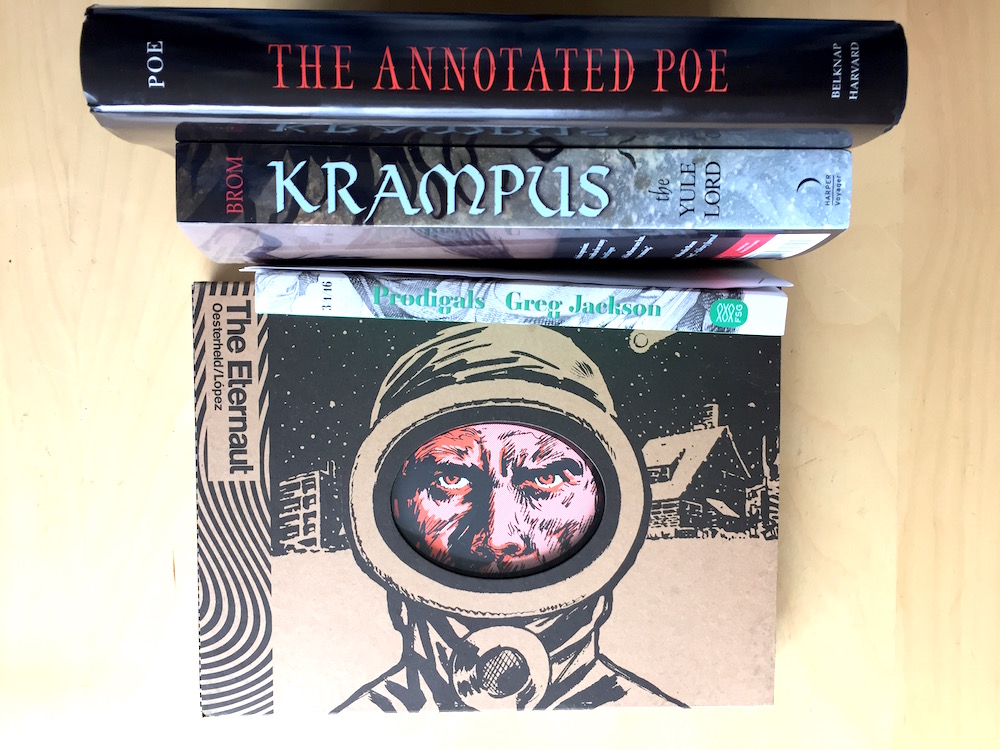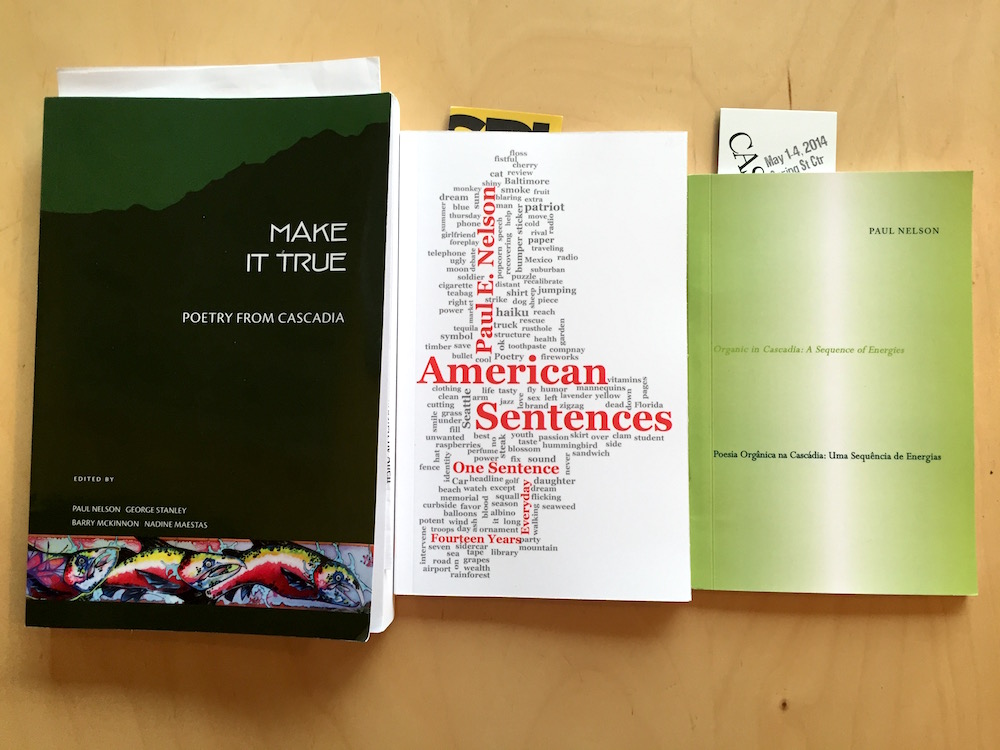An interview with Shin Yu Pai, Redmond's new Poet Laureate
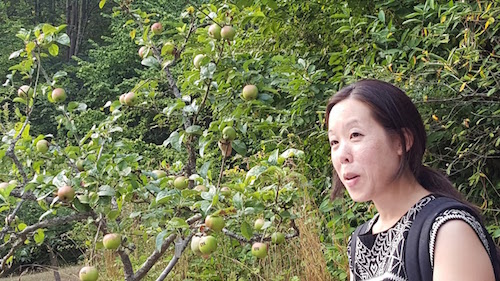
Shin Yu Pai is one of the smartest, most intellectually curious poets in the region. Her projects are always ambitious, and they string together multiple perspectives and interests — history, media, art, site-specificity — to create something new. So the news that she’s been named the Redmond Poet Laureate is especially exciting. Pai’s poetry has incorporated family history and photography and even botany to tell a new kind of story through poetry; she’s exactly the kind of poet you want to represent a city, because she is capable of thinking about all the different levels of what it means to be a city.
Congratulations on the title! Did the city approach you with the offer to be poet laureate? Did they share their reasoning for why they selected you?
The city has an open application process and I was strongly encouraged to apply by a few of the staff. I went through a panel interview and also met with the mayor in the later stages. My sense is that Redmond is very ethnically diverse, a large immigrant population, and they wanted perhaps a Laureate that could reflect a different part of its community. Past Laureates were all Caucasian. I've also had experience doing a lot of collaborative work and community engagement, as well as writing commissioned work for museums — i.e. occasional poems that were event and site specific. It may be too that I am a little bit of an unusual profile for a poet in that I am engaged in visual and public work — that is, I bring different strategies.
We’ve seen an abundance of poets laureate and similar positions created lately—we have a new Civic Poet position in Seattle, for example. What do you think your new designation means, to you and to Redmond? Why is it important to have poets laureate?
For me, the designation is an opportunity to think about a different kind of collaboration. Historically, I have worked with individual artists or groups of artists. The role as Poet Laureate represents an opportunity to collaborate with an entire community and city to bring an element of civic engagement into my work — a way to infuse poetry with a social practice element while increasing the visibility and awareness of poetry within a place. Laureates have the ability to embody, represent, and amplify underrepresented perspectives within a community — raising civic discourse through the object of a poem can be an effective tool in creating distance and different entry points into issues that can bring a new perspective or insight through creative and associative thinking.
The City of Redmond has had three previous Laureates and this program reflects a level of the city's ongoing commitment to the arts.
What do you plan on doing with the role?
I plan on co-creating and developing some programs with the public library in time for National Poetry Month in April — poetry tot time and curated exhibitions — and have some other ideas in mind. I want to treat it as an artist-in-residency and make new work through collaborations with some of the tech resources on the East side, like Digipen. Create projects that could incorporate text projection on buildings, or in the night sky. I plan on writing a poem for Redmond Lights through crowdsourcing ideas from the community based on their favorite holiday and winter films. I will also compose some texts for a temporary installation on the Redmond Connector trails. I'd like to find some way to do something with poetry and 3-D printing but that idea is still incubating. I also hear there's an orchard at the Farrel-McWhirter Farm that could lend itself to some possible installation work.
You recently grew a poem in Piper's Orchard in Carkeek Park as part of a site-specific installation called HEIRLOOM. How do you feel about that project, now that we're moving into the fall?
I miss being in the orchard every week, interacting with the trees and that project. All but a few of the apples were gone by mid-September — there was a massive wind and rainstorm that took out many of the apples in late August. I did not get to see the ripened tattooed fruit — though several photographers that I worked with were able to capture various stages. HEIRLOOM taught me about adaptation and change, giving up control of one's work to external elements. There may be future opportunities to revisit that work or to do new installations in Piper's and I want to think more about how I might do it differently based on things that I learned this season. I'm working on a book version of the project as a small run limited edition handmade book.
What are you working on next, after HEIRLOOM? Do you feel any pressure to do something even bigger and more ambitious every time you complete one project and begin another?
Some of the Redmond work will take priority. I do feel a self-imposed pressure to reinvent and innovate continually and to also pursue what's meaningful. The HEIRLOOM project took a long time and iterations to come into being — over a year — which is a very different way of working for me. I think some of that process has affected how I want to think about the kinds of work that I pursue in the future. I'm interested in continuing to bring together my different artmaking practices and interests and would love, for instance, to explore making more sound-based or vocal work. I'd also like to get back to writing personal essays about my family and history.
As we have noted repeatedly, this Thursday is Lit Crawl Seattle. But it's also important to note that Alison Bechdel will be reading at Town Hall in a sold-out edition of the 2015-2016 Seattle Arts and Lectures reading series. If you haven't yet read Bechdel's Fun Home or Dykes to Watch Out For, this excellent essay by Seattle writer Corinne Manning at Literary Hub explains her particular genius.
Variation on a theme
I’ve worn them once
my wedding shoes
dyed red, more and yes red
the way a strike against
the tip of a match ignites
and pomegranate rubies
stain a thousand secrets worth
Adam did not fall for jewels
but for the juice of a fruit
like the crimson Fujis I harvest
each fall from my backyard tree
when rusty leaves layer the ground
On Thursday, October 22nd, Lit Crawl Seattle is bringing you readings from more than 65 authors at 20 different venues. The full schedule of events is a little bit daunting. How are you supposed to choose three readings out of this embarassment of riches? Let the Seattle Review of Books help! Here's our sixth suggested itinerary:
Sometimes you're not in the mood for another short story about a man and a woman hurtling toward a divorce. Short, spare sentences about alcoholics won't do it for you. Here's the perfect itinerary for those of you who are burned out on Raymond Carver wannabes:
1. Your night starts out at The Cloud Room with a reading titled "Consider the Oyster: A Puget Sound Love Story."Food writers Langdon Cook and Sara Dickerman will read non-fiction about oysters, which press materials erroneously refer to as Seattle's "favorite bivalve" (uh, geoduck, anyone?) and Walrus & the Carpenter owner Renee Erickson will take audience questions.
2. Ada’s Technical Books hosts an indie comics reading/presentation with local cartoonists Natalie Dupille, Eroyn Franklin, Mita Mahato, and Gina Siciliano. This is a good warmup for the Short Run Comix & Arts Festival, which happens on Halloween at Seattle Center.
3. At the Pine Box, Darren Davis, Rachel Springer, James Gapinski, and Frances Dinger will read non-fiction, poetry, and fiction centering around video games.
The Invisible Art of Magazines
Published October 19, 2015, at 1:36pm
A star-studded new magazine — Haruki Murakami! Dave Eggers! Lydia Davis! Anne Carson! — has hit the scene. But is there a place for Freeman's, or has the time for magazines passed?
Check out this week's hilarious, awesome sponsor, G.G. Silverman
We love titles that tell you what you're in for (look at ours!). This week's sponsor G.G. Silverman hit the nail on the head with her book Vegan Teenage Zombie Huntress. The first two chapters , which we published on our sponsorships page, left us wanting more — and we think you'll love them too. Give it a read.
We are sponsored by independent writers and publishers who, with us, want to make internet advertising 100 percent less terrible. Help us create a new model to support the kinds of writing we bring you every day on the Seattle Review of Books.
New Hire: Sarah Glidden doesn't believe in the Seattle freeze
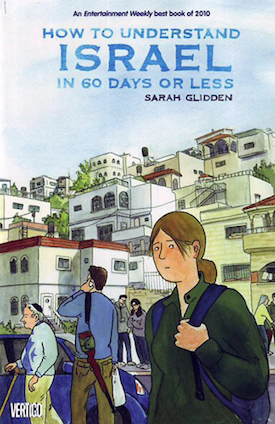
For as long as Seattle has been a city, people have come to town and people have left town. Earlier this year, the Seattle Review of Books introduced a feature called Exit Interview, in which we talk with an author who recently left town about their Seattle experience. The natural pair to that feature is New Hire, an interview with an author who’s just arrived here. (If you have any suggestions for a subject of an upcoming Exit Interview or a New Hire, please drop us a line.) Our second New Hire is cartoonist Sarah Glidden, who moved to Seattle last month. Her excellent first book, How to Understand Israel in 60 Days or Less, is a conversational and honest account of Glidden’s birthright Israel trip, which challenged her progressive beliefs. Her next book about traveling the Middle East, titled Rolling Blackouts, will be published in fall of 2016 by Drawn & Quarterly. Glidden’s comics are exactly what good journalism should be: curious, transparent storytelling with strong perspective and a solid moral center.
What brings you to Seattle? Where are you coming from?
This move is a bit of a big deal for me, because for the past four years I've been semi-nomadic. I had moved from Brooklyn to Angoulême, France, for an artists residency in 2012, where I lived for a year. Then I met my current partner, Fran, at a comics festival in Colombia, and, after some more time living out of a suitcase, ended up living with him in his hometown of Buenos Aires, Argentina for a year and a half. We talked about moving to the US, but we weren't sure where to settle down.
For years, Seattle was always a city I considered moving to. Some of my closest friends when I was living in New York were this group of people from Seattle, and a bunch of them decided to move back in 2006 to start a non-profit journalism collective (now known as the Seattle Globalist). My mother and stepfather also moved to Vancouver, BC around the same time, so I started coming out to the Pacific Northwest for visits. Seattle started growing on me, especially its natural beauty. When Fran and I came out here for a visit together, he fell in love with it too, and we started talking seriously about moving here.
We considered some other cities, but in the end Seattle just felt right for us. We have friends here, my family is close by, it's green even in the winter. This is the first time since I moved to New York at the age of 22 that I’ve come to a new city with the intention of staying. It’s pretty exciting and also terrifying in a way.
What do you think Seattle can do for you as an author?
It can give me some space to think. This is a great city for taking walks, and walking is pretty important for me; it’s how I resolve writer’s block or even just get ideas. If I don’t have a space to do that, I can end up staying in my studio all day, which isn't very healthy. There are so many incredible spots within the city that feel like an escape to someone from the east coast: parks with incredible views of the mountains, giant trees, beaches...and these are things that I can visit without taking significant time out of my work.
I'm also excited to see what kind of work I can do here once I'm finished with my current book. I work in non-fiction, and usually the comics I make are inspired by the things around me that make me curious. I already have so many ideas for stories based on what I'm being exposed to in Seattle, issues that are unique to this city but that I also think would resonate with people anywhere.
What do you think you can contribute to Seattle's literary scene?
I’m really excited to get involved with the literary scene here in whatever way I can, although I don’t really know what that will look like yet. I’ve recently started teaching comics, and I would love to do more of that here.
I’m also just looking forward to meeting other writers, getting to know their work, going to events. I even signed up for a class at the Hugo House, though I really shouldn’t be doing that right now (I should be finishing my book!)
Seattle has a vibrant and fast-growing comics community. Can you talk about your experience with the community here? Were you already familiar with the scene?
The comics community here was definitely a factor when we decided to move here. I remember visiting the Fantagraphics store during my very first visit to Seattle and feeling like I was making a pilgrimage. I think I even had a friend take my picture in front of the shop window. I had just started making comics at that time and Fanta was putting out some of the work I loved the most, so the whole city felt a little more extraordinary because of that.
During my visits I started meeting other cartoonists who are based here and in Portland, and I started getting a real sense for how special the community was. I got to know Eroyn Franklin pretty well, and then watched from afar with admiration as she and Kelly Froh started Short Run and turned it into one of the most talked-about indie festivals in the country.
It didn't take long to get involved with the scene once I moved here. I've already taught a workshop through Short Run's Summer School series and I'll be helping out with the festival at the end of the month (you can find me helping out at the bake sale table). I'm pretty busy for the next couple of months, but after that I'd really love to get even more involved.
If you could add one feature to Seattle's artistic community, what would it be?
I don't really have an answer for this one! So far, I have everything I need here. I guess I wish public transportation were a little better so it would be easier to get to all the different neighborhoods where so many of the studios, galleries, event spaces, art supply shops are. But from talking to people who have lived here for a long time, its clear that the state of public transportation in Seattle is not a new gripe to have.
Has anything about life in Seattle surprised you so far?
People are incredibly friendly. I heard so much about the “Seattle freeze” before we moved here, and I had prepared myself for a kind of cold city. I was actually really nervous about that! If you're a person who loves people but you work from home, the interactions you have when you go to the grocery store or run errands start to become very important to you. New York is full of people who are ready to just start talking to strangers at the slightest provocation (to the extent that some people find it invasive and annoying) and I was sad to leave that behind. But people here seem to be very warm and genuine and happy to chat. I don't know where Seattle's chilly reputation comes from. Maybe its a defense to keep more people from moving here. It's also possible that I'll see a different side to the city once winter sets in. For now I'm still in the honeymoon phase of living here and its still sunny out, so I'll enjoy it while it lasts.
Your Week in Readings: The best events from October 19th to 26th
MONDAY Start the week off with some librarians at a Bookish Happy Hour at the Diller Room. This is part of Seattle Public Library’s Booktoberfest program, which brings librarians, beer, and you together in non-traditional venues.
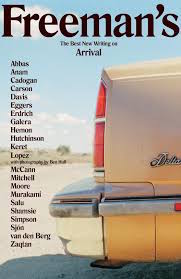
But of course, because I’m involved in that event, I’m naturally biased. So allow me to present an ALTERNATE TUESDAY event for your edification. At Town Hall Seattle, Jack Nisbet will appear in conversation with John Marzluff, a professor of wildlife science, and geologist David Montgomery. Nisbet’s newest book Ancient Places explores the relationship between the landscape and the culture of the Pacific Northwest,.
WEDNESDAY The WordsWest Literary Series will happen at C&P Coffee Company in West Seattle. This is a monthly reading series that brings new and established talent to a neighborhood that doesn’t see very many literary events. Tonight’s readers are KUOW journalist Ruby de Luna, who has reported on immigrant communities and health care, and Stephanie Timm, an author who recently wrote a play titled Tails of Wasps and co-authored an adaptation of The Ramayana with Yussef el Guindi.
THURSDAY Obviously, you’re going to Lit Crawl Seattle. This is not optional.
FRIDAY Elliott Bay Book Company hosts two novelists who have been published by the wonderful publisher Akashic Books. Joe Meno will read from his new novel, Marvel and a Wonder, which is about a farm, horse-racing, and family. Nina Revoyr’s new novel Lost Canyon is about four backpackers who go on a trip that finds them outside of their comfort zone.
SATURDAY University Book Store presents a special reading with Seattle author G. Willow Wilson and writer Margaret Stohl. They’ll be signing their new books: Wilson’s latest comic is A-Force, which features an all-woman team of superheroes, and Stohl recently published a young adult novel starring the Marvel character Black Widow. While mainstream comics is slowly opening up to women, it’s still a predominantly male-dominated field. This is a rare chance to meet and talk with two women who have made names for themselves and thrived in that industry. Go show them some love.
SUNDAY Hugo House hosts a reading from Floating Bridge Press chapbook winners. Every year, great local publisher Floating Bridge Press sponsors a contest that finds a new poet and publishes their work. This year’s winner is Michael Schmeltzer, who will read from his chapbook, Elegy/Elk River. (He’s also got a book coming out soon from Two Sylvias Press.) Several finalists from the contest— Maya Jewell Zeller, Brian Cooney, and Linda Malnack — will also read. This is a great chance to see some new poets do their thing; you’ll likely be seeing these names around town for years to come. Why not get a head start tonight?
Collateral Damage
Published October 18, 2015, at 4:27pm
A found poem constructed out of the The Intercept_’s report on the Obama administration's drone war.
The Sunday Post for October 18, 2015
Pond Scum: Henry David Thoreau’s moral myopia.
Oh, how I love Kathryn Schulz's takedown of Thoreau in the latest New Yorker! I've never been a fan of Henry David, and we see his offspring littering the Pacific Northwest hiking trails, beaches, and REIs — especially on sale days. This was a delicious read for me.
The real Thoreau was, in the fullest sense of the word, self-obsessed: narcissistic, fanatical about self-control, adamant that he required nothing beyond himself to understand and thrive in the world. From that inward fixation flowed a social and political vision that is deeply unsettling. It is true that Thoreau was an excellent naturalist and an eloquent and prescient voice for the preservation of wild places. But “Walden” is less a cornerstone work of environmental literature than the original cabin porn: a fantasy about rustic life divorced from the reality of living in the woods, and, especially, a fantasy about escaping the entanglements and responsibilities of living among other people.
Mea culpas in kidlit
Meaghan O'Connell published a light-hearted piece in New York Magazine titled The Children's-Book Guy: An Ideal Crush Object. It's about how hot she found many of the young male illustrators of kids books. Although post-ironic and tongue-in-cheek (it's tagged with the title The Female Gaze), it drew a lot of negative attention from the kidlit crowd, who have been facing the same sort of gender issues the rest of publishing has. That is, it's mostly made of women, but the men get all the attention. They win the Caldecott awards. They get the bigger book deals. They get called cute and asked to show up on panels, at the sake of women not being invited. So O'Connell was taken to task for writing without knowledge of this context.
The great moral to this, though, is that O'Connell read the responses, and after understanding them, came out with a heartfelt apology and explanation.
In my personal writing I am often second-guessing and making fun of, or light of, my less admirable impulses. I am trying to write from a place of confidence, yes, but also fallibility, because I think that’s interesting, and true. This was definitely at work in that piece, but is often the first thing to get lost when people are understandably upset. Which MAKES SENSE.
Anyway that’s my own context. The greater context, I was more than a little horrified to discover, is an industry that is, yes, like most of publishing, female majority (more women writing, illustrating, editing, agenting, and BUYING books), but like most of publishing — and I should have known this, it was naive to assume otherwise — men get much of the credit, the glory, the jokey posts about how hot they are. CRINGE. I slowly learned this yesterday as a few very kind women shared some links with me, like this one, and this one: “Why Don’t Women Win Caldecott Awards?” Yikes. (And yes, this is about when I wanted to crawl into a cave and die.)
Speaking in Tongues
Josephine Livingstone goes deep into invented languages for the New Republic.
“Conlang” is short for “constructed language,” which is just what it sounds like: a language that has been constructed. There are a lot of them, of various sorts. International auxiliary languages like Volapük, Esperanto, or Interlingua are one specific type of conlang. Invented to facilitate international communication during the great techno-utopian-modernist thought-boom of the last two centuries, they never got terribly popular. Conlangs do not necessarily have to be useful. As Peterson explains in his new book The Art of Language Invention, conlanging is an art as well as a science, something you might do for your own pleasure, as well as for the entertainment of others. He is a conlanger for hire—besides Game of Thrones, Peterson has also worked on Syfy’s Defiance, in which humans and aliens coexist in postapocalyptic Missouri—an artist who will put words into the mouths of the characters, words which are part of a fully functioning language.
Is the world real, or is it just an illusion or hallucination?
I was thinking about linking today to a very long piece about Carlos Castaneda that Longreads.com recently published. But I'd rather get deep and philosophical in a more scientific way.
Hopes&Fears's Marina Galperina asked "neuroscientists, physicists, psychologists, technology theorists, and hallucinogen researchers if we can ever tell whether the 'reality' we are experiencing is 'real' or not."
The closest we come in science to "real" or "objective" is intersubjective agreement. If a large number of people agree that something is real, we can assume that it is. In physics, we say that something is an objective feature of nature if all observers will agree on it - in other words, if that thing doesn’t depend on our arbitrary labels or the vagaries of a given vantage point ("frame-independent" or "gauge-invariant", in the jargon). For instance, I'm not entitled to say that my kitchen has a left side and a right side, since the labels "left" and "right" depend on my vantage point; they are words that describe me more than the kitchen. This kind of reasoning is the heart of Einstein's theory of relativity and the theories it inspired.
Thanks to Mark Taylor for sponsoring this week!
Our thanks to sponsor Mark Taylor -- have you looked yet at the chapter from his work Assassin Rabbit From the Dawn of Time?
Mark is getting ready to release the ebook version soon, and we added a handy-dandy email signup form on the page allows you to add your name to his email list lickity-split, so you'll know when that happens.
Of course, it's all part of our campaign to make internet advertising 100% less terrible. Check out Mark's work, put your email down to signup for his list, and consider buying the book -- we've enjoyed having him as a sponsor.
Rahawa Haile’s short stories of the day, of the previous week, for October 17, 2015
Every day, friend of the SRoB Rahawa Haile tweets a short story. She gave us permission to collect them every week. She's archiving the entire project on Storify
Short Story of the Day #282
"Wait but what if instead of stereotypes you wrote the women in your novel like people?" pic.twitter.com/UQiLXxMyGZ
— Rahawa Haile (@RahawaHaile) October 11, 2015Short Story of the Day #283
Kawika Guillermo's "The Hole"
Birkensnake (2013)
http://t.co/LRbHbCeZWT pic.twitter.com/rmVqxEE65q
— Rahawa Haile (@RahawaHaile) October 11, 2015Short Story of the Day #284
Nicole Smith's "The Broken Pattern"
Meridian (2014)
http://t.co/u0aZxa2AKq pic.twitter.com/UQbAi57Ho7
— Rahawa Haile (@RahawaHaile) October 13, 2015Short Story of the Day #285
Meredith Turits's "You Told Me I Looked Good"
Hobart (2015)
http://t.co/tXgfVUCsO0 pic.twitter.com/BtcnAbouW9
— Rahawa Haile (@RahawaHaile) October 14, 2015Short Story of the Day #286
Reem Abu-Baker's "Common Usage"
Timber (2014)
http://t.co/kh8n5erJFi pic.twitter.com/5xduT6CprZ
— Rahawa Haile (@RahawaHaile) October 15, 2015Short Story of the Day #287
Heather O'Neill's "Swan Lake for Beginners"
http://t.co/PKFJMIntRY pic.twitter.com/1N6FD5SpR1
— Rahawa Haile (@RahawaHaile) October 15, 2015Short Story of the day #288
I am on vacation. I saw the Pacific for the first time. I'm incredibly happy to finally know both of our oceans.
— Rahawa Haile (@RahawaHaile) October 17, 2015On Thursday, October 22nd, Lit Crawl Seattle is bringing you readings from more than 65 authors at 20 different venues. The full schedule of events is a little bit daunting. How are you supposed to choose three readings out of this embarassment of riches? Let the Seattle Review of Books help! Here's our fifth suggested itinerary:
Today's suggested Lit Crawl itinerary celebrates the writers and organizations who are best known for creating captivating reading experiences.
1. APRIL Festival opens your night at Hugo House with "A Salty Reading," in which Sonya Vatomsky, Richard Chiem, and Princess Charming all offer salt-themed performances. In addition to presenting entertainers who know how to keep an audience on tenterhooks, APRIL also will provide free salt and vinegar chips tonight, for no real reason except it's funny.
2. At Fred Wildlife Refuge, Sean Beaudoin, Robert Lashley, and Amber Nelson will read on the theme of sex, drugs, and violence. Nelson and Beaudoin are both excellent readers, but Robert Lashley gave the best performance I've seen all year at the APRIL Festival. His reading style is absolutely compelling, and he's sure to be a highlight of Lit Crawl, too.
3. Seattle Public Library's own David Wright presents "Spooky Stories in the Stacks" at the Capitol Hill Branch Library. This is exactly what it sounds like: scary stories being read aloud at the library. What the hell else could you possibly want in a reading?
Podcast #1: The Art of Commerce talked with Third Place Books managing partner Robert Sindelar about the pleasures and problems of running a bookstore. (If you're wondering, the Seward Park Third Place Books is still scheduled to open early in 2016.)
Podcast #2 I talked with Brad Craft and Nick DiMartino for the 50th episode of their delightful Breakfast at the Bookstore podcast. We discussed the importance of criticism, what we've been reading lately, and why Martin McClellan and I started the Seattle Review of Books.
The Help Desk: The other Help Desk
Every Friday, Cienna Madrid offers solutions to life’s most vexing literary problems. Do you need a book recommendation to send your worst cousin on her birthday? Is it okay to read erotica on public transit? Cienna can help. Send your questions to advice@seattlereviewofbooks.com.
Dear Cienna,
We can’t help but notice that several months after your weekly advice column, The Help Desk, launched on the Seattle Review of Books — to be specific, the first one was published on July 31, 2015 at 10:01am, PST — the New York Times Book Review is preparing to launch a literary advice column this week called Help Desk. You've written nine of these columns so far. Our question is: what the fuck do you think is going on there?
(heart,)
Martin and Paul, downtown
Dear Martin and Paul,
Ideas are always stolen, they don’t even have to be great ones. Russia stole the idea for invading Ukraine from the Poles, Michael Jackson stole moonwalking from the moon – or at the very least, astronauts – astronauts stole Tang from diabetes, and diabetes stole my grandmother’s pancreas. There’s no use being a frown clown; that’s just how the world works.
Here’s a more personal example: For awhile now, I’ve planned on having a baby and naming it Spite. The baby changes depending on my audience – for instance, if I’m frustrated with my grandmother and her lazy pancreas, Spite is half-black because it makes her deeply uncomfortable. I’ve told a few close friends about my Spite baby, including the spider that lives in my bathroom. Lo and behold, I get home from work yesterday to find my spider friend has hatched 1,000 babies on my bathroom wall. You guessed it: that bitch named every one of them Spite.
I could take it personally. Hell, I could shovelize her and her offspring in a heartbeat but she’s done nothing but be a good friend and sympathetic listener who knew a great idea when she heard one and ran with it.
The New York Times can offer book advice. They can even steal the name of our book advice column. But this is the same media outlet that taunts its readers with achingly beautiful portraits of homes we can never afford in places only those too poor to leave reside (“What You Get: $900,000 homes in Mississippi, Pennsylvania, Ohio”? Go fuck yourself, NYT), and thus it will never possess the charm, compassion and practical advice of a single woman living in a $500 rental full of pet spiders.
Kisses,
Cienna
The only Help Desk endorsed by spiders™.
Portrait Gallery: Eileen Myles
Each week, Christine Larsen creates a portrait of a new author for us. Have any favorites you’d love to see immortalized? Let us know
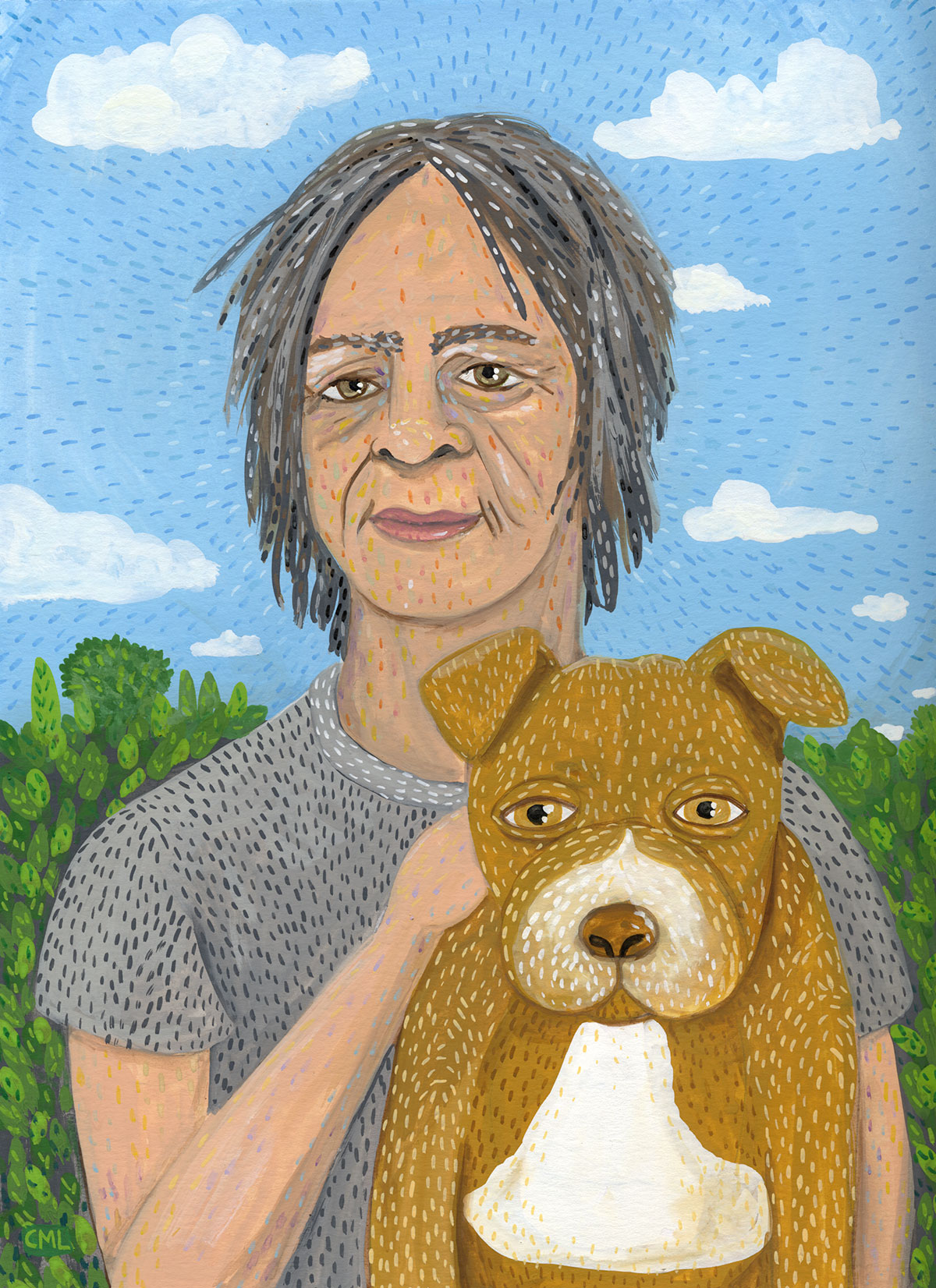
Everybody's talking about Eileen Myles this week! That's because she'll be reading at Elliott Bay Book Company on Saturday. You should go see her. Until then, here she is with her dog, Honey.
On Thursday, October 22nd, Lit Crawl Seattle is bringing you readings from more than 65 authors at 20 different venues. The full schedule of events is a little bit daunting. How are you supposed to choose three readings out of this embarassment of riches? Let the Seattle Review of Books help! Here's our fourth suggested itinerary:
Look: sometimes you don't want to go to a reading just to hear some moron white guy complain about being a white guy. I get it. Everyone gets it. God, they just won't shut up! Here's an itinerary that does not include a single white male.
1. The Frye Art Museum is hosting an evening of Native writers reading poetry and prose. Here's the lineup:
Laura Da’ (Eastern Shawnee), Sasha LaPointe (Nooksack), Casandra Lopez (Chicana, Cahuilla, Luiseño, Tongva), and Sara Marie Ortiz (Pueblo of Acoma). Elissa Washuta (Cowlitz) hosts.
2. Women's writing colony Hedgebrook hosts the second event of the night at Sole Repair. Allison Green, Frances McCue, Felicia Gonzalez, and Anne Liu Kellor read new work, most of which was probably written at Hedgebrook on Whidbey.
3. VIDA closes out your evening at Fred Widlife Refuge, with women of color reading new prose. Readers include Shannon Barber, Jennine Capo Crucet, and Wendy C. Ortiz.
This NPR interview with once and future Bloom County cartoonist Berkeley Breathed is full of weird little surprises. Chief among those surprises? The connection between Bloom County and Harper Lee.
Thursday Comics Hangover: The end of Ms. Marvel
(Every comics fan knows that Wednesday is new comics day, the glorious time of the week when brand-new comics arrive at shops around the country. Thursday Comics Hangover is a weekly column reviewing some of the books I pick up at Phoenix Comics and Games, my friendly neighborhood comic book store.)
The world ends in superhero comics all the time. DC Comics published a company-wide crossover called Final Night almost twenty years ago in which superheroes and their supporting casts believed their worlds were about to end for real (no, for really real this time). This summer, Marvel Comics did basically the same thing as part of their big crossover, Secret Wars. They published “last issues” of their comics under the banner “Last Days Of…” with the premise that the world is about to end for real (no, for really real this time) and so their characters are forced to come to peace with the idea that they are powerless to stop the destruction of the universe. Like most of the Secret Wars crossover, the idea started strong but has gone on for way too long.
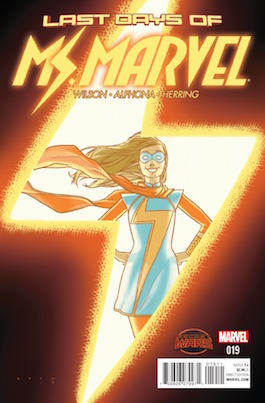
Ms. Marvel has always been a dance between outrageous superhero adventure and the soap-operatic story of Kamala Khan, a teenage Pakistani-American Muslim growing up in Jersey City. The standard superhero tropes are all at play — can Khan keep her superhero life a secret from her hyper-conservative parents? — but Wilson’s low-key script and Alphona’s cartoony art kept the stakes at a happily human scale. Marvel Comics hasn’t debuted a superhero this promising in decades.
But that’s all old news. Yesterday, Marvel “ended” the series, and Wilson and Alphona took the opportunity to write a real, honest-to-goodness last issue for Ms. Marvel. As good as the series has been, this last issue is even better. Though she knows the world is ending, Khan doesn’t turn into Ms.Marvel,or use her shape-shifting powers even once in the issue. Instead, she has heartfelt conversations with her mother, with a friends, with other members of her supporting cast. These conversations, all of which take place in or around a high school in which residents of Khan’s Jersey City neighborhood are taking shelter from the apocalypse, are alternately touching, awkward, and earnest.
Relying as it does on dialogue crammed into a series of tiny bubbles, it’s surprising that this issue works as well as it does. Wilson is gifted at the haiku of comics scripting — seriously, count the number of words in a given comics issue and you’ll have a better appreciation of how hard it is to write dialogue for the medium — and Alphona does the rest of the work with his characters’ emotive faces and expressive body language. They’ve grown as a team over the two years that they’ve worked on the book, and this issue is the payoff for all that hard work. Rather than going out with a silly fight or existential angst, Ms. Marvel instead faces the end of the world as a human being.
Look, we all know it’s comics, and that Ms. Marvel is a popular book, and that nobody’s going to disappear forever. But the trick that Wilson and Alphona pull off in this issue is they take an overplayed gimmick and they use it as an opportunity to allow the characters to speak their minds and open their hearts and demonstrate how they’ve changed since we’ve first met them. This is a hell of an accomplishment: it’s an ending that leaves you desperate to read the next chapter.
